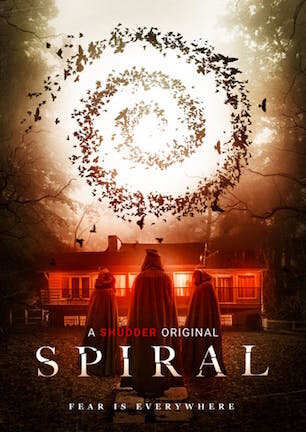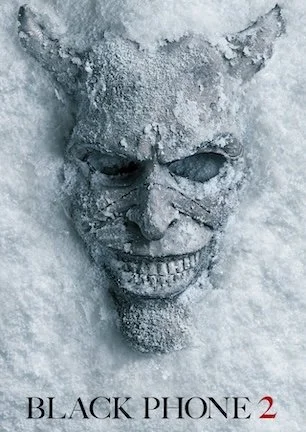Studio: Shudder
Director: Kurtis David Harder
Writer: Colin Minihan, John Poliquin
Producer: Colin Minihan, Kurtis David Harder, John Poliquin
Stars: Jeffrey Bowyer-Chapman, Ari Cohen, Jennifer Laporte, Ty Wood, Lochlyn Munro, Chandra West
Review Score:
Summary:
A same-sex couple moves to a seemingly idyllic suburb, but comes to suspect their neighbors may belong to a sinister secret cabal.
Review:
Released on Shudder in 2020, you’re likely to see “Spiral” tied to a 2019 date because that’s when the film did its festival tour. It’s not to be confused with “Spiral: From the Book of Saw” or with the “Ringu” sequel also titled “Spiral.” For that matter, it shouldn’t be confused with another Japanese horror film using the same name or with any of the other 50+ movies, TV series, individual episodes, or shorts that have been called “Spiral” since 1998 alone. You’ll probably hear this particular “Spiral” reductively referred to as “Get Out themed around homophobia instead of racism” since that’s an easy way to quickly identify it in the morass of changing dates and repeated nomenclature.
“Spiral” mostly stays behind the eyes of Malik. Malik is in a same-sex relationship with Aaron, whose teenage daughter Kayla comes from a previous marriage. Looking to leave the big city rat race for the quiet comfort of a serene suburb, the trio moves out of Chicago and into a cozy corner that might be another Mayberry, at least on the outside.
“Spiral” presents this trio like any typical film family. Malik and Aaron glow with optimism during every early display of affection. Kayla routinely rolls her eyes whenever she can be bothered to take her earphones off long enough to sigh with sarcasm. Then comes the customary “cute” scene where dad embarrasses daughter by singing along to an upbeat pop song only for everyone to eventually join an impromptu dining room dance party. Ah, they always have it so easy in the first ten minutes. Will something sinister sour these happy faces?
That something sinister starts sneaking in when Malik and Aaron meet the neighbors. Their smiles appear welcoming to Aaron. Malik senses something amiss in their suggestiveness, particularly the hitch of hesitation when one woman realizes they’re gay.
Malik’s radar really lights up when unusual instances grow more worrisome. Strange stares from a distance turn into stalkers directly outside the house. Condescending comments couched in conversation become inflamed interactions aimed at alienating the couple from the community. Malik feels certain the neighbors have unkind intentions. Aaron assures Malik he’s being irrational because of past trauma where bigots brutalized an ex-boyfriend.
“Spiral’s” story builds slowly. An eccentric old man slips Malik a seemingly blank piece of paper. Malik finds a curious book with a spiral on its spine in a neighbor’s house, although he doesn’t open it. Close-ups of clocks show specific times such as 3:10 and 1:10. To Malik, every oddity appears to be a weird warning he should be wary of. To viewers, they’re just confounding clues we have no context for. Like the flashback snippets from a larger event only Malik knows the full truth about, we’re given cryptic crumbs that add up to evil for him, but mean nearly nothing to us. As in, sure the strange spiral book seems curious I guess, but what exactly makes it eerie?
“Spiral” continues keeping its mystery hidden using illogical behavior bearing a baffling lack of urgency. I don’t know about you, but if I came home to my new house to find a disparaging slur spray-painted on an interior wall, I’d immediately say to my partner, “Hey, maybe we don’t want to be here. At a minimum we need to be more guarded with our neighbors.” What I wouldn’t do is keep that crime to myself, quietly paint over said slur, discover a personal photo stolen as well, secretly install a security system, get a note from a crazy man who suspiciously dies the next day, witness a cult ritual, do research revealing a history of unexplained murders, and then finally mention something to my significant other.
Likewise, when a supernatural apparition drops a VHS videocassette at your feet, the first thing you do is put that hot potato in the nearest VCR. You don’t break up with your boyfriend, bail someone out of police custody, visit a neighbor, then check into a motel room before remembering, “Oh yeah, maybe I should watch the tape that ghost threw at me.”
Creating psychological suspense sometimes requires futzing with storytelling structure. But there’s a vast difference between building a mystery and merely prolonging one at the expense of audience interest.
In the middle of this sits a side story where Kayla develops a romantic relationship with neighborhood teenager Tyler. Kayla has a boyfriend back in Chicago, so there’s a complication there. Tyler also has own fling going with another girl, much to Kayla’s chagrin. Then there’s a ‘will they/won’t they’ element with regard to Kayla wanting to lose her virginity to Tyler. It raises an eyebrow that two writers thought this thin high school soap opera held any intrigue when there’s a far more critical cult-oriented conspiracy concurrently on the table.
“Spiral” means well as both commentary and as an “is this really happening or is it all in his head?” chiller. Trouble comes from trying to have its cake and eat it too by quizzically blending tangible thrills with hallucinatory horror. The result is a messy mixture that fumbles the film’s fiction. By in effect revealing both possibilities are at least partially in play, twists fail to connect to clear explanations, and muddle the movie’s message along with the story.
Around this unconvincing foundation the film pours in tropes including a disbelieving husband, shrieking female phantoms, suddenly waking from nightmares, doing research at a library, and creeping around with a flashlight while shouting “hello?” at noises in darkness. “Spiral” thus ends up hitting for par on a beginner’s course for a paranoia drama, which doesn’t offer nearly enough uniqueness to stand out from every other same-named fright film competing for the horror crowd’s attention.
Review Score: 55






Compelling performances keep “Hallow Road” swimming as strongly as possible against the strong current of a drowsy pace.